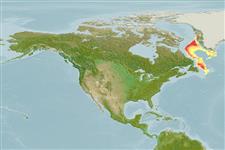Classification / Names
Nombres comunes | Sinónimos | Catalog of Fishes(Género, Especie) | ITIS | CoL | WoRMS | Cloffa
Environment: milieu / climate zone / depth range / distribution range
Ecología
marino batidemersal; rango de profundidad 0 - 3172 m (Ref. 58018). Deep-water
Northwest Atlantic: south of Greenland.
Tamaño / Peso / Age
Maturity: Lm ? range ? - ? cm
Max length : 4.8 cm SL (female)
Short description
Morfología | Morfometría
Radios blandos dorsales (total): 38; Radios blandos anales: 31 - 33; Vértebra: 43. Coronal pore present. Opercular flap large, triangular and prominent, anus on vertical through gill opening. Gill opening reaching ventrally in front of 2-3 pectoral rays. Gill rakers unmodified. Pectoral fin rays of lower lobe equal in thickness to rays of upper pectoral fin lobe. Skin with yellowish-brown patterns; head beneath skin blackish-brown; gill arches and gill cavity brownish-black (Ref. 43481).
Life cycle and mating behavior
Madurez | Reproducción | Puesta | Huevos | Fecundidad | Larva
Chernova, N.V. and D.L. Stein, 2002. Ten new species of Psednos (Pisces, Scorpaeniformes: Liparidae) from the Pacific and North Atlantic oceans. Copeia 2002(3):755-778. (Ref. 43481)
IUCN Red List Status (Ref. 130435)
Threat to humans
Harmless
Human uses
Más información
Nombres comunesSinónimosMetabolismoDespredadoresEcotoxicologíaReproducciónMadurezPuestaAgregación para la puestaFecundidadHuevosEgg development
Age/SizeCrecimientoLength-weightLength-lengthLength-frequenciesMorfometríaMorfologíaLarvaDinámica larvariaReclutamientoAbundanciaBRUVS
ReferenciasAcuiculturaPerfil de acuiculturaRazasGenéticaElectrophoresesheritabilidadEnfermedadesProcesamientoNutrientsMass conversion
ColaboradoresImágenesStamps, Coins Misc.SonidosCiguateraVelocidadTipo de nataciónSuperficie branquialOtolitosCerebrosVisión
Herramientas
Special reports
Download XML
Fuentes de Internet
Estimates based on models
Preferred temperature (Ref.
123201): 3.3 - 4.3, mean 3.7 °C (based on 65 cells).
Phylogenetic diversity index (Ref.
82804): PD
50 = 0.5000 [Uniqueness, from 0.5 = low to 2.0 = high].
Bayesian length-weight: a=0.01000 (0.00244 - 0.04107), b=3.04 (2.81 - 3.27), in cm total length, based on all LWR estimates for this body shape (Ref.
93245).
Nivel trófico (Ref.
69278): 3.2 ±0.5 se; based on size and trophs of closest relatives
Resiliencia (Ref.
120179): Alto, población duplicada en un tiempo mínimo inferior a 15 meses (Preliminary K or Fecundity.).
Fishing Vulnerability (Ref.
59153): Low vulnerability (10 of 100).
